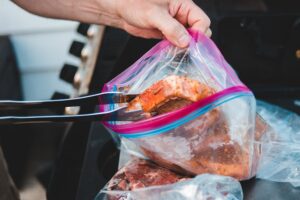So, you open your fridge all set to prep for Thanksgiving, only to find your turkey has turned pink.
Before panic sets in and you resign yourself to ordering takeout, let’s talk in-depth about why this happened and reassure you that a pink turkey doesn’t always mean disaster.

Turkey Turned Pink in Fridge – Possible Causes and Solutions
Finding your turkey turned pink in the fridge might be a bit startling, but it’s not necessarily a cause for alarm. Here are some potential reasons and steps you can take:
Nitrate Contamination
Pink turkey meat can occur if the bird has been treated with curing agents containing nitrates, commonly found in certain brines or processed meats. These nitrates react with the turkey’s proteins, causing a pinkish hue.
Solution: If your turkey is labeled as “pre-brined” or “enhanced,” check the ingredients for curing agents or nitrates. To avoid this in the future, choose a natural, unprocessed turkey or brine it yourself with nitrate-free ingredients.
Improper Thawing
Thawing turkey in the fridge is safe but needs careful handling. If the turkey was not completely thawed before cooking, the outer layers might cook faster than the inner parts, leading to uneven coloration.
Solution: Ensure your turkey is fully thawed before cooking. Allow approximately 24 hours of thawing time per 5 pounds of turkey in the refrigerator.
If you’re short on time, consider using the cold water thawing method, ensuring the turkey is tightly sealed to prevent water contamination.
Reaction With Certain Minerals
Turkey meat can sometimes react with minerals in tap water, especially if it has a high iron content. This reaction can result in a pinkish color, though the meat is still safe to eat.
Solution: Use filtered or distilled water for brining or cooking, especially if your tap water is high in iron.
If your turkey has already turned pink due to this reaction, it’s safe to eat as long as it reaches the recommended internal temperature of 165°F (74°C) during cooking.
Metal Interaction
Sometimes, when certain metals, such as aluminum or copper, come into contact with the turkey, a chemical reaction can occur. This reaction may lead to the formation of pinkish compounds, affecting the color of the meat.
Solution: To prevent metal interaction, store the turkey in non-reactive containers. Use food-grade plastic or glass for storage, and avoid aluminum foil directly touching the meat.
Additionally, cook and reheat turkey in cookware made of stainless steel, cast iron, or other non-reactive materials.
Packaging Reactions

The packaging materials used for the turkey may contain chemicals that react with the meat, causing discoloration. This is especially true for some plastic wraps or containers that may leach into the turkey over time.
Solution: When storing turkey, opt for packaging that is labeled as food-safe and free from harmful chemicals.
Consider transferring the turkey to airtight, food-grade containers or wrapping it in parchment paper before placing it in the fridge. If the turkey is pre-packaged, check for any specific storage instructions provided by the manufacturer.
Nitrate or Nitrite Presence
Nitrate or nitrite compounds, commonly used in curing agents or certain brines, can react with the proteins in the turkey meat, resulting in a pink color.
These compounds are often present in processed meats and some pre-brined turkeys.
Solution: Review the ingredients of pre-brined or processed turkey to check for nitrate or nitrite content.
If you prefer to avoid these compounds, choose natural, unprocessed turkey or brine it yourself using nitrate-free ingredients.
Ensure you follow proper brining guidelines and recommended concentrations to maintain the quality and safety of the meat.
Sodium Bicarbonate (Baking Soda) Use
If you used a brine or marinade that contains baking soda (sodium bicarbonate), it can sometimes react with the proteins in the turkey, leading to a pinkish discoloration.
Solution: Avoid using excessive amounts of baking soda when preparing a brine or marinade. Opt for recipes that balance acidity and other flavors without relying heavily on alkaline substances.
If your turkey has already turned pink due to this reaction, ensure it reaches the recommended internal temperature during cooking, as it is safe to eat.
Oxygen Exposure
Also, you should note that prolonged exposure to oxygen can cause a reaction known as oxidation, resulting in a pinkish or brownish color on the surface of the turkey.
This is more common in areas where the meat is not well-sealed or exposed to air during storage.
Solution: To minimize oxygen exposure, tightly wrap the turkey in plastic wrap or aluminum foil, ensuring there are no gaps for air to enter. Consider using vacuum-sealed bags or airtight containers for storage.
Trim any discolored parts before cooking if the oxidation is limited to the surface.
Aging Process
Over time, enzymes in the turkey meat can break down proteins, altering the color and texture.
While this aging process is natural, it can sometimes result in a pinkish hue, especially if the turkey has been stored for an extended period.
Solution: If you notice a pink tint due to the aging process, check the overall quality of the meat. Smell and texture can indicate if the turkey is still safe to eat.
It’s advisable to use the turkey promptly or freeze it to maintain its freshness if in doubt.
Microbial Growth
If the turkey has been contaminated with spoilage bacteria or other microbes, it can lead to discoloration. Microbial growth can sometimes produce pigments that alter the color of the meat, including a pinkish hue.
Solution: Always adhere to proper food safety practices. Ensure the turkey is stored at the correct temperature (below 40°F or 4°C) and consumed within a reasonable time frame.
If you suspect microbial contamination, check for any off-putting odors or sliminess. When in doubt, it’s safer to discard the meat.
Marination with Acidic Ingredients
Marinating the turkey with acidic ingredients like citrus juices or vinegar for an extended period can sometimes lead to a pinkish tint. The acids can react with the meat, causing changes in color.
Solution: Limiting the marination time to prevent color changes if using acidic marinades.
Alternatively, marinate the turkey in the refrigerator for a shorter duration or use marinades with less acidic content. Ensure that the marinade is well-drained before cooking.
Artificial Color Additives
Some pre-packaged or processed turkeys may contain artificial color additives. These additives, if not evenly distributed, can result in uneven coloration, including areas of pink.
Solution: Check the ingredient list on the packaging for any artificial color additives. If possible, choose natural or minimally processed turkey options.
If you’ve already purchased a turkey with artificial additives, follow the cooking instructions carefully to ensure thorough and even cooking.
Cross-Contamination

This can occur if raw turkey comes into contact with other foods in the fridge. If juices from the turkey transfer to other items, it can cause a pink discoloration in those areas.
Solution: Store raw turkey on a tray or in a sealed container on the fridge’s bottom shelf to prevent cross-contamination. Keep uncooked meats separate from ready-to-eat foods.
Clean and sanitize surfaces or containers that come into contact with raw turkey juices promptly.
How to Assess Your Turkey Spoilage
There are various reasons your turkey might have turned pink, and not all of them spell disaster. It could be a harmless reaction with metals, a quirk in the packaging, or even the presence of certain additives.
The key here is to understand that the color change doesn’t automatically mean your turkey is destined for the trash.
Before you start envisioning a Thanksgiving without the star of the show, take a deep breath. The pink tint doesn’t necessarily indicate spoilage. In fact, many factors unrelated to safety could be at play.
So, let’s explore the possibilities and, more importantly, how to salvage your turkey and rescue your holiday meal.
Foul Odor
Give your turkey a good whiff. If it smells off or has a distinctly unpleasant odor, that’s a red flag. Spoiled meat often emits a foul, sour, or rancid smell that your nose won’t miss.
Sliminess
Run your hands over the surface of the turkey. If it feels excessively slimy or sticky, it’s a cause for concern. Fresh meat should be moist but not overly slippery.
Off Texture or Appearance
Trust your eyes and fingers. If the texture seems unusual, like a slimy film or an excessively tacky feel, or if there are significant changes in color beyond the pinkish tint like gray, then it’s most likely spoilt.
Conclusion
In conclusion, discovering a pink turkey in your fridge can be a perplexing and slightly alarming experience.
While it’s natural to worry about the safety of the meat, understanding that the pink color can be caused by a reaction with the turkey’s myoglobin and oxygen can offer reassurance.
Remember, if the turkey has been stored correctly and reached the recommended internal temperature when cooked, it should be safe to eat.
However, if uncertainty persists, it’s always better to prioritize food safety, consult a professional, or opt for an alternative.
